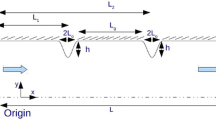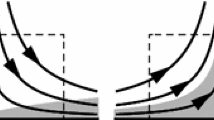Abstract
A mathematical model of ATP/ADP reaction at the surface of the endothelium for any two-dimensional or axisymmetric nonsingular functional form of the wall shear stress has been presented. Excellent agreement is obtained with the numerical solution for the parallel plate case. For spatially varying wall shear stress, such as the stagnation point flow and a backward facing step the ATP concentrations are shown to have a maximum at the stagnation point streamline and the reattachment point respectively. Increasing the Reynolds number increases both the ATP and ADP concentrations. For the backward facing step significant spatial variations occur in the concentration. Hence, a strong controlling factor for physiological kinetic values is the geometry of the arterial vessel since this determines the wall shear stress and thence the transport to the reactive surface. The area of high concentration also occurs where the wall shear stress is low (limiting case is zero shear stress). Atherosclerotic plaques are known to occur in areas of low wall shear stress and at vessel bifurcations where the wall shear stress is spatially varying. The ATP/ADP concentrations at these particular points may very well contribute to the formation of plaques. © 2003 Biomedical Engineering Society.
PAC2003: 8719Tt, 8710+e, 8380Lz
Similar content being viewed by others
References
Barakat, A. I., E. V. Leaver, P. A. Pappone, and P. F. Davies. A flow-activated chloride-selective membrane current in vascular endothelial cells. Circ. Res. 85:820–828, 1999.
Bird, R. B., W. E. Stewart, and E. N. Lightfoot. Transport Phenomena. New York: Wiley, 1960.
David, T., S. Thomas, and P. G. Walker. Platelet deposition in stagnation point flow: An analytical and computational simulation. Med. Eng. Phys. 23:299–312, 2001.
David, T., S. Thomas, and P. G. Walker. Platelet deposition in stagnation point flow: An analytical and computational simulation. In Proceedings of the 1998 IMA Conference “Cardiovascular Flow Modelling and Measurement with Application to Clinical Medicine,” edited by T. Sajjadi, G. Nash, and C. Rampling, 1999, pp. 49–58.
David, T., and P. G. Walker. Activation and extinction models for platelet adhesion. Biorheology39:475–481, 2002.
Dull, R. O., and P. F. Davies. Flow modulation of agonist (ATP)-response (Ca2+) coupling in vascular endothelial cells. Am. J. Physiol. 261:H149–H154, 1991.
Gordon, J. L. Extracellular ATP: effects, sources and fate. Biochem. J. 233:309–319, 1986.
John, K., and A. I. Barakat. Modulation of ATP/ADP concentration at the endothelial surface by shear stress: Effect of flow-induced ATP release. Ann. Biomed. Eng. 29:740–751, 2001.
Karino, T., and H. L. Goldsmith. Aggregation of human platelets in an annular vortex distal to a tubular expansion. Microvasc. Res. 17:217–237, 1979.
Milner, P., K. A. Kirkpatrick, V. Ralevic, V. Toothill, J. Pearson, and G. Burnstock. Endothelial cells cultured from human umbilical vein release ATP, substance P and acetylcholine in response to increased flow. Proc. R. Soc. London, Ser. B 241:245–248, 1990.
Mo, M., S. G. Eskin, and W. P. Schilling. Flow-induced changes in Ca2+ signaling of vascular endothelial cells: Effect of shear stress and ATP. Am. J. Physiol. 260:H1698–H1707, 1991.
Nollert, M. U., and L. V. McIntire. Convective mass transfer effects on the intracellular calcium response of endothelial cells. J. Biomech. Eng. 114:321–326, 1992.
Olesen, S.-P., D. E. Clapham, and P. F. Davies. Haemodynamic shear stress activates a K+ current in vascular endothelial cells. Nature (London)331:168–170, 1988.
Shen, J., M. A. Gimbrone, F. W. Luscinskas, and C. Forbes Dewey. Regulation of adenine nucleotide concentration at endothelium-fluid interface by viscous shear flow. Biophys. J. 64:1323–1330, 1993.
Shen, J., F. W. Luscinskas, A. Connolly, C. Forbes Dewey, and M. A. Gimbrone. Fluid shear stress modulates cytosolic free calcium in vascular endothelial cells. Am. J. Physiol. 262:C384–C390, 1992.
Author information
Authors and Affiliations
Rights and permissions
About this article
Cite this article
David, T. Wall Shear Stress Modulation of ATP/ADP Concentration at the Endothelium. Annals of Biomedical Engineering 31, 1231–1237 (2003). https://doi.org/10.1114/1.1615574
Issue Date:
DOI: https://doi.org/10.1114/1.1615574




